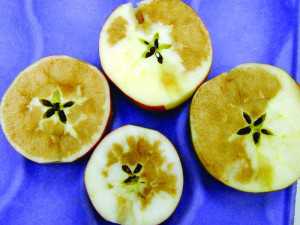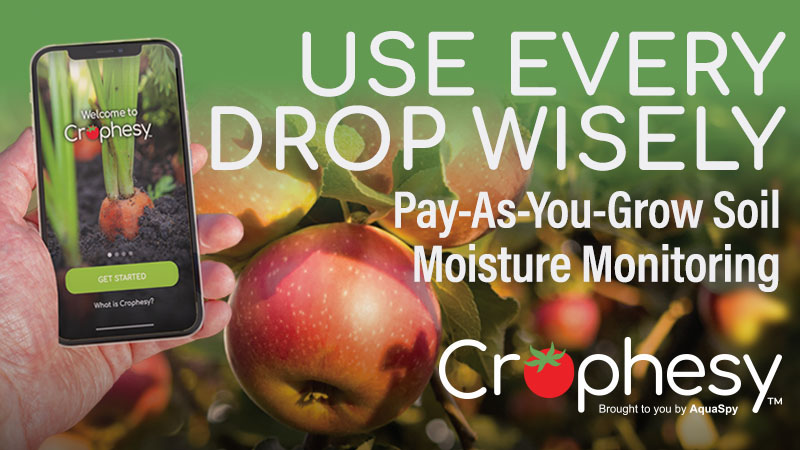The Dark Side Of Honeycrisp

Finicky. Biennial. Heat intolerant. Bruises easily. Tough to store. If these characteristics were listed for any apple cultivar being developed, it wouldn’t leave the research station.
But this isn’t just any research cultivar. It’s Honeycrisp.
Ask any grower whether they enjoy the experience of growing Honeycrisp year in and year out and they’ll likely tell you no. But it’s a necessary evil. Without Honeycrisp — one of the most profitable varieties to have in an orchard — many growers believe they can’t stay competitive.
Despite its sweet name and popularity in the market, there’s a dark side to America’s darling apple.
“It is by far and away the most difficult variety I’ve ever grown,” says Bruce Allen, president of Columbia Reach Pack in Yakima, WA.
A Challenge To Grow
There are so many nuances to successfully growing Honeycrisp, the choices a grower makes will have a proportionally greater impact how Honeycrisp will behave. The variety requires more attention and inputs to get a desired yield.
“It wants to crop too early, and it can runt out,” says Jennifer DeEll, fresh market quality program leader of the Ontario Ministry of Agriculture, Food and Rural Affairs. “(It has) brittle wood which requires extra support, and the tree will break off at whatever height your post is.”
Rootstock choice impacts how productive the variety will be. Since it is a low-vigor cultivar, larger rootstocks can cause Honeycrisp to become biennial bearing. DeEll says some rootstocks also cause trees to break off or cause nutrient deficiencies. Hand thinning is a necessity and over-cropping can produce small fruit and cause the tree to become biennial bearing.
Honeycrisp is very susceptible to black rot, powdery mildew, and fire blight. Heat and sunburn are also issues with Honeycrisp. Fruit grows on the larger size, especially in early years.
A Challenge To Harvest And Store
“Honeycrisp has thin skin, which is easily punctured. This can lead to more storage rots going into retail,” says DeEll.
Many growers choose to stem-clip apples and gently place them in bins to prevent bruising, says Bruce Turner, national marketing representative for Oneonta Starr Ranch Growers. This extra precaution can double harvest costs, though.
Honeycrisp’s propensity to grow big can also lead to bitter pit. The disorder may be present at harvest, but will worsen as the apples are stored.
“You can lose anywhere from 20% to 30% of your crop when it’s hanging on the trees just with bitter pit,” says Mark Boyer of Ridgetop Orchards, LLC, in Fishertown, PA. “There’s always that fine line between having too much a crop to make it go biennial bearing or too [small] of a crop that you can have a lot of bitter pit.”
A grower’s best defense against bitter pit is calcium sprays, DeEll says.
As if growers didn’t have enough trouble on their hands with Honeycrisp during the growing season, the variety is also prone to physiological disorders such as soft scald and soggy breakdown. CA storing is problematic, too because it is very sensitive to chilling and carbon dioxide.
“Conditioning the fruit prior to cold storage is extremely important. Holding at 10°C for seven days can substantially reduce soft scald and soggy breakdown during subsequent cold storage at 3°C,” DeEll says. “Warmer temperatures for conditioning can also aggravate bitter pit development, so 10°C seems to be the best compromise for these disorders.”
Boyer says the ironic thing about needing to precondition is the apples that should be stored are your first picks, but that is when the markets are most favorable. He said his family has to wage the war on bitter pit in the orchard to prevent losses in storage. And, storage disorders affect packouts.
“You spend a lot of time and money on the management of the harvest of it so you’re getting a nice quality Honeycrisp to put out there. Then you pack it,” Boyer says. But if you’re storing it, then your third picking or a later picking of Honeycrisp is more susceptible to soggy breakdown.”
 The Changing Market
The Changing Market
Given that it’s such a challenging variety to grow, there’s only one reason growers continue to stick with it — the returns.
“Growers are still obviously attracted to Honeycrisp because it’s currently or it has been over the last few years by far one of the most profitable varieties to grow,” says Allen.
With the profitability of this variety, growers are ramping up production. Both Allen and Turner see production doubling in the next four years. Estimates of 12,000,000 cartons by 2018-2019 are forecast. This is up from 3,158,000 in 2010-2011, according to the Washington Apple Commission.
“It will probably increase by 150%, maybe 200% over the next 10 years,” says Allen.
Both Allen and Turner see the risk if growers rush to be the first to hit the market.
“There is a very real temptation to be first to market each autumn and get those new crop high prices,” Turner says. “In recent seasons, we’ve seen green, immature fruit hit retail that simply doesn’t eat well.”
If consumers have an unpleasant eating experience, they will likely turn their preferences elsewhere.
“I’ve heard one large grower call it ‘Killing the Goose that Lays the Golden Eggs,’” says Turner. “We cannot disappoint a single consumer, we will need every one of them loving their Honeycrisp and buying even more a few years from now.”
Although production has increased, growers have not met the demand for year-round availability. The market for Honeycrisp is changing, though.
“Until recently, Honeycrisp prices remained firm even when supplies increased because it was getting wider distribution and staying on the market longer,” says Desmond O’Rourke, publisher of the World Apple Report. “The support for the Honeycrisp prices from increased distribution is gradually being eroded.”
O’Rourke says a key indicator for this is premium payouts in 2013-2014 vs. the same time period this season.
“Last year, Honeycrisp prices from Washington State averaged about $54 per 40-lb box at FOB for the September-December period,” says Desmond O’Rourke. “For the same period this year, they averaged about $43, a 20% decrease. For the same period, Honeycrisp shipments from Washington State were up about 50%.”
The Future Of Honeycrisp
“The era of sky high Honeycrisp prices is over. They still sell at a very nice premium to most varieties,” O’Rourke says.
He says as Honeycrisp becomes more readily available, high-income consumers will shift their preference to other premium varieties.
With this change in the market Allen says he knows some large growers who are not adding more Honeycrisp acres.
“There are several growers that I know of in Washington state that have fairly significant plantings that have indicated to me that they are not going to plant anymore. The reason being it’s such a difficult variety to grow, a lot of strain on the management system in terms of trying to get it picked properly, that they simply don’t think they can properly manage further increases in production on their own operations.”
However, with the market changing Boyer does see a bright spot with Honeycrisp.
First, Honeycrisp has singlehandedly introduced a wide span of consumers to the characteristics of a modern eating apple — crunch, sweetness, flavors, eye appeal, etc.
“People are really starting to understand what a really great eating apple experience is,” he says. “There’s a lot of great apple varieties coming down the road that our customers are going to walk in to a store in the future, look at a shelf and almost every single apple on there is going to be a great eating experience.”
Second, the changing market prices for Honeycrisp might help spread the demand for the variety.
“I talked to people that said ‘can you believe that Honeycrisp is going for $1.99 a pound and the rest of the other fruit is $0.99 a pound,’” he says. “They look at it like fuel prices (going down). Does that make the consumer consume more? I think so.”
Turner says that although growers might eye the large crop as the beginning of the end, grocers, on the other hand, see large numbers as a good thing.
“Retailers are still very excited about Honeycrisp — I had one retailer tell me he thinks we should increase our rate of new planting,” he says.
And, there are still people who haven’t tasted a Honeycrisp yet. But when they do, they’ll come back for more.
“The bright side is simply that 8 out of 10 people if given a high-quality Honeycrisp think it’s absolutely the best apple they’ve ever eaten and they want more,” Allen says.
Despite all the negatives of Honeycrisp, most growers, like Boyer acknowledge that Honeycrisp is a must-have.
“It’s always a love-hate relationship with Honeycrisp. What would you do without it? You just can’t live without it,” he says.
The returns Boyer and his family received from Honeycrisp allowed them to reinvest back into their orchard, increase high-density plantings, build cold storage facilities and purchase new equipment.
“Before Honeycrisp came around, we weren’t riding around with brand new tractors, brand new sprayers. Before Honeycrisp came around, we weren’t putting up cold storage buildings. We weren’t planting high density because our margins were kind of small,” he says.

Soggy breakdown in Honeycrisp.
Advice On Taming Honeycrisp’s Dark Side
Growers, marketers and researchers, offer advice to growers who have seen the dark side of Honeycrisp.
- Mark Boyer of Ridgetop Orchards, LLC, in Fishertown, PA: I wouldn’t even fool around with the regular strains of Honeycrisp, I’d wait to get the all-red Honeycrisp. The second thing is I would really pay attention to your tree spacing, and don’t rush to crop it, fill out your spacing that you intended, and do everything in your power to get bitter pit under control, and realize that it’s almost like cherries – it’s a heartbreak crop, you win some you lose some.
- Bruce Allen, President, Columbia Reach Pack: Be careful about planting more Honeycrisp. If you truly have a really good site, I wouldn’t hesitate to plant more. But it’s very site specific. Be very careful about the assumptions you make regarding what Honeycrisp are going to be sold for in the future. Be very careful about what you think you can do as a grower. Honeycrisp is going to challenge you.
- Jennifer DeEll, fresh market quality program leader of the Ontario Ministry of Agriculture, Food and Rural Affairs: Don’t be greedy. Don’t skimp on labor. Don’t try to get a crop too early. Don’t try to save sprays. Be sure to know and understand optimum handling and storage regimes for Honeycrisp. Otherwise you get could get large losses fast.
- Bruce Turner, national marketing representative for Oneonta Starr Ranch Growers: Grow it right, harvest it at the optimal time, and make sure every apple is an excellent eating experience.










